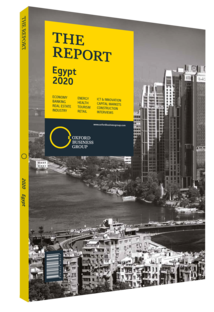How Egypt is growing its non-banking financial services segment
Egypt’s non-banking financial services (NBFS) segment is widely seen as underpenetrated, and it is thus expected to witness considerable growth throughout the coming five-year period to 2025, due to Egypt’s favourable demographics. Support efforts from the Egyptian government, the Financial Regulatory Authority (FRA) and the Central Bank of Egypt (CBE) will help drive this growth and manage risk.
Performance
These efforts include setting a minimum paid-in capital for companies financing small and medium-sized enterprises (SMEs) and those offering microfinance lending worth LE20m ($1.2m) and LE5m ($308,200), respectively; requiring microfinance companies and non-government organisations (NGOs) intending to offer leasing services to allocate a minimum lending amount of LE10m ($616,300), to present separate financial statements for the line of business and to hold separate financial books; urging NGOs and lending companies offering microfinance loans to provide insurance coverage for their borrowers equivalent to their outstanding loans; and obliging leasing companies to abide by nine financial solvency standards, including a minimum capital adequacy ratio of 10% with a three-year target of 12%, an additional 4% capital adequacy requirement in case industry or client concentrations exceed 30% of the total leasing portfolio and a maximum debt-to-equity ratio of 9:1.
According to FRA data, Egypt’s microfinance loan portfolio grew at a three-year compound annual growth rate (CAGR) of 54%, reaching LE16.5bn ($1bn) in 2019, with beneficiaries growing at a CAGR of 19% over the same period to 3.1m, while the average loan size increased from LE2453 ($151.18) in 2016 to LE5304 ($326.89). Individual beneficiaries dominated around 80% of total loan book value, versus 20% for group beneficiaries. Egypt’s population, which grew at an average of 2.4m per year over the past four years, acts as a strong microfinance market growth catalyst, as does Egypt’s low banking sector penetration rate.
Financial leasing now comprises leasing and factoring after a 2018 law from the FRA merged the two activities, part of the government’s effort to ensure reachability to non-banking financial tools. The value of Egypt’s leasing contracts increased by 34% annually to LE55.9bn ($3.5bn) in 2019, while the number of new contracts increased 25% annually to 2944, according to the FRA. The value of factored securities remained unchanged in 2019, at LE10.6bn ($653.3m). Leasing contracts booked in the fourth quarter of 2019 amounted to LE17.9bn ($1.1bn), increasing by around 25% year-on-year and around 19% quarter-on-quarter, which is considered the highest level of quarterly leasing contracts booked over the past two years, and which we attribute to the 350-basis point rate cut that took place over the third and fourth quarters of 2019.
Other NBFS activities include insurance, consumer finance and mortgage finance. In February 2020 Parliament approved the consumer finance law, paving the way for strong growth for this type of financing. As for mortgage finance, the CBE introduced a LE50bn ($3.1bn) initiative for middle-income housing at a declining 8% interest rate, after previously introducing a LE20bn ($1.2bn) initiative for low-income housing.
Projection
In early 2020 the CBE announced an interest rate cut of 300 basis points in response to the Covid-19 pandemic, and the FRA instructed leasing and factoring companies to postpone collections from their clients for six months without any late fees. These developments, coupled with the initiatives mentioned above, make for a positive a NBFS outlook, especially microfinance and leasing businesses, even in light of the potential negative impacts from the pandemic. In 2020-24 Egypt’s microfinance portfolio is estimated to grow at a CAGR of around 20% to LE40.3bn ($2.5bn), with 5.2m beneficiaries. Excluding factoring, leasing contracts are anticipated to grow at a CAGR of around 25% to LE170bn ($10.5bn) over the same period, leading to strong opportunities for market participants.
You have reached the limit of premium articles you can view for free.
Choose from the options below to purchase print or digital editions of our Reports. You can also purchase a website subscription giving you unlimited access to all of our Reports online for 12 months.
If you have already purchased this Report or have a website subscription, please login to continue.

